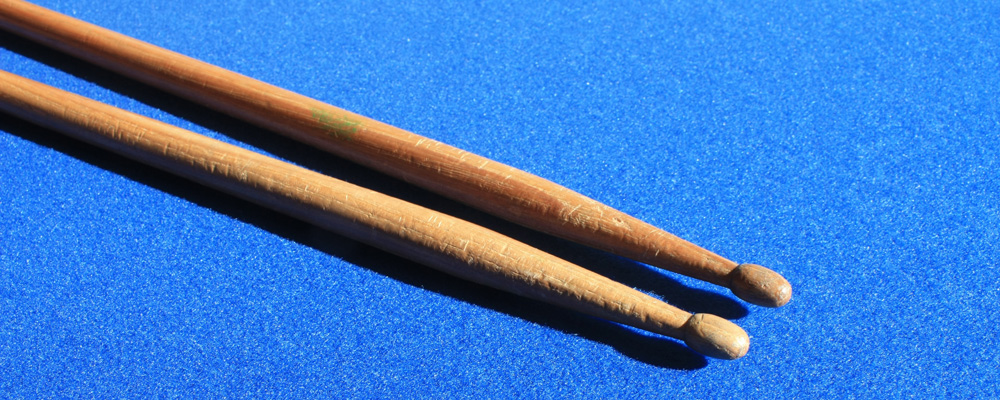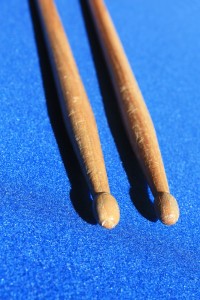What You Need to Know About…Drumsticks

This article originally ran in the May/June 2010 issue of Drum Business.
by Fran Azzarto
Drumsticks aren’t overly mystifying, yet there is information that you should be able to draw from when choosing a particular size or model. Here are some of the questions you might be asking.
What do the numbers and letters mean?
The history behind the numbers and letters stamped on drumsticks is a little foggy. The letters originally stood for styles of music, while the number was related to the stick’s diameter. The larger the diameter, the lower the number. Some of this coding still applies to today’s basic stick models. Here’s a breakdown of what the companies used back in the early 1900s, when this system was first established:
- The letter A stood for orchestra.
- The letter B stood for marching and concert bands.
- The letter S stood for street band.
- The letter D, used by Gretsch, stood for dance band.
- 2B is the most common size for a thick stick.
- 7A is the most common size for a thin stick.
Most stick manufacturers still offer the classic models: 2B, 5A, 5B, and 7A. As Pat Brown of Promark puts it, “Beyond that, most companies have adopted their own individual systems for naming or numbering sticks, and usually those names or numbers are little more than generic part numbers that bear little or no relevance to the size or shape of the stick.” So in order to keep your customers from getting overwhelmed by the options as they search for the right stick, consider having pairs in the basic sizes nearby to help guide you in the right direction.
What’s the difference between sticks made of hickory, maple, oak, and plastic?
The most common types of wood used today are hickory and maple. Maple is 10 percent lighter than hickory, which allows drummers to use a larger-diameter stick without it being too heavy. Maple also plays a bit faster. It wears out pretty quickly, however. Hickory is a harder wood and will last longer than maple. Hickory is also fairly resilient and can absorb the shock of a hard-hitting drummer. Oak is the heaviest wood option. Promark’s Japanese Shira Kashi white oak sticks are 10 percent heavier than those made with American hickory. The extra density means oak sticks can withstand more intense playing styles. Advertisement
The bottom line is that oak will last the longest. Hickory has a natural feel, takes an average amount of punishment, and is the most versatile of the three wood types. Maple will allow for more sensitivity and may be better suited to lighter playing situations.
For extreme durability, check out the aluminum/ plastic sticks by Ahead. These drumsticks are made of aerospace-grade aluminum tubing, and the upper half has a replaceable polyurethane cover with a threaded tip. These sticks are designed to last, while still offering a comfortable playing experience. According to Ahead, “Our sticks have up to 50 percent less shock and can last up to ten times longer than most similarly sized wood models.”
- Hickory is of medium weight and durable.
- Maple is lightweight and quick.
- Oak is heavyweight and durable.
- Aluminum/polyurethane sticks provide extra rebound and are extremely durable.
How does the stick’s tip shape affect the sound?
There are five basic shapes of drumstick tips, and each one produces a different sound and has a different feel, especially when it comes to playing cymbals. Advertisement
- Oval: largest spectrum of sound
- Teardrop: warm with focused low tones
- Round/ball: clean, bright, and crisp
- Acorn: full, rich, and fat
- Barrel: punchy and loud
When choosing sticks, consider the type of music you play. Do you need to be heard over a couple of Marshall amps? If so, a barrel-style nylon-tip model could work best.
What’s the difference between wood and nylon tips?
According to Mark Dyke at Vic Firth, “The drummer will choose between a wood- and nylon-tip stick based on the desired sound color of the cymbal. Nylon tips create a brighter sound than wood.” Also, nylon tips are virtually indestructible, so nylon tips will far outlast wood tips. Regal Tip’s unique E series nylon tip is designed to offer the durability of plastic with the warmer sound of wood.
- Nylon: long-lasting tip, bright sound
- Wood: full and warm sound
- Regal Tip E series: durable tip, warm sound

What effect does lacquering have on the sticks?
Lacquer seals the wood and stabilizes moisture content. It can also help provide a more comfortable grip. Regal Tip’s three-step lacquer process is designed to take the comfort level one step higher. According to Regal Tip’s Carol Calato, “This lacquer finish will actually get a slight tacky feel when your hand heats up as you play.” Advertisement
Some lacquers are too thick for certain drummers; those players will need a model that’s closer to raw wood. If your hands sweat very easily, a stick with a lot of lacquer can be very difficult to hold on to. A “specialty grip” stick may be the best choice; these models feature non-slip coating toward the butt end.
- Lacquered: slick feel, moisture resistant
- Unlacquered: tight grip, susceptible to moisture-content changes
- Grip stick: no slippage, moisture resistant
What’s the best size and model for a beginner?
One size does not fit all. If a student has small hands (either because of age or stature), the most logical recommendation would be a smaller stick than one used by someone with a larger hand. But some experimentation is required to find what feels most comfortable. A 7A is a good choice for someone with small hands, like a young student. A 5A is the most common model for average-size teenage or adult hands. Some companies offer a stick that is specifically made to fit the small hands of a young drummer. Those include Vic Firth’s SD 1 Jr., Vater’s Junior Sticks, and Promark’s SD1F Future Pro.
Consider the size of your hand, and play a couple of hits on a rubber pad using different sticks. If the stroke looks a bit out of control with a thin stick, try a thicker model. Control is everything for a beginning drummer, and finding the correct size of stick is a crucial element in developing proper technique. Advertisement
And be sure to check out our other What You Need to Know About features here.



